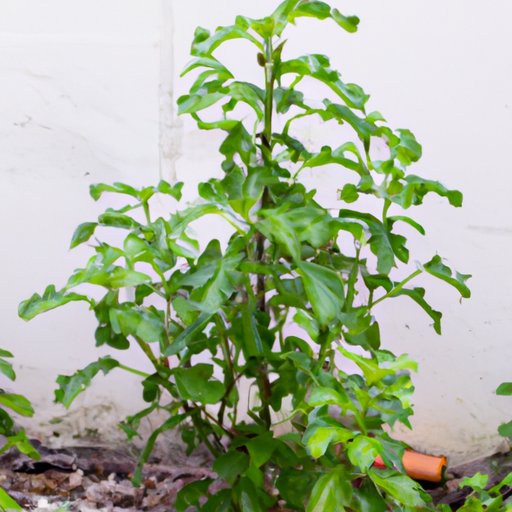Introduction
Citronella plants are a type of grass native to tropical regions such as Asia and South America. The plant’s leaves contain citronella oil, which gives it its characteristic odor. Citronella oil is commonly used in candles, sprays, and other products to repel mosquitoes and other insects. In addition to its practical uses, citronella plants are also valued for their decorative qualities and are often used in landscaping and gardening projects.
This article aims to provide a comprehensive guide to citronella plant size and growth patterns, with helpful tips and advice for growing these plants effectively. Understanding the size and behavior of citronella plants is essential for maintaining their health and appearance, as well as maximizing their mosquito-repelling properties.

The Ultimate Guide to Growing Citronella Plants: Size and Height
One of the most important things to consider when growing citronella plants is their size and height. While citronella plants may look like typical grasses, they can grow to be much taller and thicker than other types of grass. On average, citronella plants can grow to be between 5 and 6 feet tall, with a maximum height of up to 8 feet in some cases. In addition to height, citronella plants can also spread outward up to several feet wide.
Factors that influence the growth of citronella plants
Several factors can influence the growth and size of citronella plants, including:
- Soil quality: Citronella plants need well-draining soil and ample nutrients to grow to their full potential.
- Sunlight: Citronella plants require plenty of sunlight to thrive, with a minimum of 6 hours of direct sunlight per day.
- Temperature: Citronella plants are sensitive to cold temperatures and cannot survive frost or freezing conditions.
- Water: Citronella plants need consistent moisture, but overwatering can lead to root rot and other issues.
- Maintenance: Regular pruning and fertilization can help promote healthy growth in citronella plants.
Optimal growing conditions for citronella plants
To ensure optimal growth and health, it’s important to create the right growing conditions for your citronella plants. Here are some tips to keep in mind:
- Choose a location with plenty of sunlight and well-draining soil.
- Water your citronella plants regularly, but be careful not to overwater.
- Fertilize your plants regularly with a balanced fertilizer high in nitrogen.
- Prune your plants regularly to keep them in shape and prevent overgrowth.
- Be mindful of temperature changes, and protect your plants from frost or freezing conditions.
Everything You Need to Know About the Height of Citronella Plants
Understanding the growth patterns of citronella plants
Citronella plants have a unique growth pattern that is different from other types of grasses. These plants grow in clumps, with new shoots sprouting up from the base of the plant. Over time, new shoots can cause the plant to become crowded and overgrown, which can affect its overall size and appearance.
Tips for monitoring the height of citronella plants
To keep your citronella plants at their optimal height, it’s important to monitor their growth regularly. Here are some tips to keep in mind:
- Use a ruler or measuring tape to measure the height of your plants periodically.
- Keep track of how quickly your plants are growing, and adjust your pruning and watering schedule accordingly.
- Look for signs of overgrowth, such as crowded clumps or yellowing leaves.
How to deal with overgrown citronella plants
If your citronella plants become overgrown, there are several steps you can take to restore their health and appearance. These include:
- Pruning back your plants to remove excess growth and help them regain their shape.
- Transplanting your plants to a larger container or a more spacious garden area.
- Thin out crowded areas to allow more space for new growth and airflow.
Citronella Plant Size: How to Control the Growth
Pruning and trimming
One of the most effective ways to control the growth of citronella plants is by pruning and trimming them regularly. This helps to remove excess growth and promote healthy new shoots. When pruning your citronella plants, be sure to use sharp, clean shears and avoid cutting too much at once.
The importance of proper spacing
Proper spacing is also essential for controlling the growth of citronella plants. These plants need plenty of room to spread out, so be sure to plant them at least 2 to 3 feet apart to prevent overcrowding.
Other growth control methods
In addition to pruning and proper spacing, there are several other methods you can use to control the growth of citronella plants:
- Use a balanced fertilizer high in nitrogen to promote healthy growth.
- Water your plants only when necessary, and avoid overwatering.
- Consider transplanting your plants to larger containers or garden areas as they grow.
The Secret of the Citronella Plant: Knowing How Big It Gets
Common misconceptions about the size of citronella plants
It’s important to dispel some common misconceptions about the size of citronella plants. Many people assume that these plants are small and manageable, but in reality, they can grow to be quite large and require specific growing conditions to thrive. Understanding the true size of citronella plants is essential for successful growth and maintenance.
The true size of citronella plants
As previously mentioned, citronella plants can grow to be between 5 and 6 feet tall, with some reaching up to 8 feet in ideal growing conditions. It’s important to keep this in mind when planning your garden or landscape design, as these plants can quickly become overgrown if not managed properly.
Planning citronella plants in landscaping and gardening
Citronella plants can be a beautiful addition to any garden or landscape, but it’s important to plan their placement carefully. Consider the size and growth patterns of these plants when choosing a location, and be sure to plant them at least 2 to 3 feet apart to prevent overcrowding. Additionally, consider the specific growing conditions needed for citronella plants, such as plenty of sunlight and well-draining soil.
Citronella Plants 101: How to Grow and Manage their Height
Basic care guidelines for citronella plants
Here are some general care guidelines to follow when growing citronella plants:
- Choose a location with plenty of sunlight and well-draining soil.
- Water your plants regularly, but be careful not to overwater.
- Fertilize your plants with a balanced fertilizer high in nitrogen.
- Prune your plants regularly to prevent overgrowth and promote healthy growth.
- Protect your plants from frost and freezing temperatures.
Monitoring and managing the height of citronella plants
To keep your citronella plants at their optimal height, it’s important to monitor their growth regularly. Use a ruler or measuring tape to measure the height of your plants periodically, and adjust your pruning and watering schedule as needed. If your plants become overgrown, consider transplanting them to a larger container or garden area, or thinning out crowded areas.
Combining citronella plants with other mosquito control methods
While citronella plants are an effective mosquito-repelling solution on their own, they can also be combined with other mosquito control methods for maximum effectiveness. Consider using citronella candles or sprays in addition to your citronella plants, or incorporate other natural repellents such as lavender or lemongrass into your garden design.
Growing Citronella Plants for Mosquito Control: Learn about their size and growth patterns
How citronella plants help with mosquito control
Citronella plants are known for their ability to repel mosquitoes and other insects with their unique scent. By planting citronella plants in your garden or outdoor spaces, you can create a natural barrier against mosquitoes and reduce your risk of mosquito-borne illnesses.
The correlation between plant size and mosquito control effectiveness
The size and growth patterns of citronella plants can also play a role in their effectiveness as a mosquito repellent. Larger plants with healthy growth patterns are more likely to produce the scents and oils needed to repel mosquitoes effectively. By monitoring and maintaining the health of your citronella plants, you can help ensure that they are providing optimal mosquito control.
Conclusion and future considerations
Citronella plants are a valuable addition to any garden or outdoor space, providing a natural, eco-friendly solution for mosquito control. By understanding the size and growth patterns of these plants and following proper care guidelines, you can grow healthy, beautiful citronella plants that are effective at repelling mosquitoes. As you plan and design your garden or landscape, consider incorporating citronella plants for both their practical and decorative qualities.
Recap of key points
- Citronella plants can grow to be between 5 and 6 feet tall, with some reaching up to 8 feet in ideal growing conditions.
- Factors that influence the size and growth of citronella plants include soil quality, sunlight, temperature, water, and maintenance.
- Proper care and maintenance, including pruning, spacing, and fertilization, can help control the growth of citronella plants.
- By incorporating citronella plants into your landscape, you can create a natural barrier against mosquitoes and reduce your risk of mosquito-borne illnesses.
Final thoughts and recommendations
Citronella plants are a simple yet effective way to control mosquitoes and other insects naturally. Whether you’re adding them to your garden or using them for landscaping, be sure to follow proper care guidelines and monitor their growth regularly for optimal results. By incorporating citronella plants into your outdoor spaces, you can enjoy a beautiful, fragrant garden while keeping mosquitoes at bay.
(Note: Is this article not meeting your expectations? Do you have knowledge or insights to share? Unlock new opportunities and expand your reach by joining our authors team. Click Registration to join us and share your expertise with our readers.)
